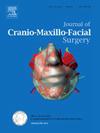下颌磨牙后区块骨与夹心骨修复牙槽裂的比较:回顾性研究。
IF 2.1
2区 医学
Q2 DENTISTRY, ORAL SURGERY & MEDICINE
引用次数: 0
摘要
本回顾性研究旨在评估下颌磨牙后区骨移植物重建牙槽裂的效果,并比较块骨移植物和夹层骨移植物(由“皮质骨+松质骨+皮质骨”组成的结构)的成骨特性。共有22例患者参与,并根据所使用的骨移植类型分为两组。主要观察指标包括术后6个月评估裂区体积、填充率、成骨率和骨吸收率。结果表明,核裂区体积对充填率有显著影响,充填率与成骨率呈线性关系(p本文章由计算机程序翻译,如有差异,请以英文原文为准。
Comparison of block bone and sandwich bone graft from posterior region of mandibular molar for alveolar cleft repair: A retrospective study
This retrospective study was designed to assess the efficacy of alveolar cleft reconstruction using bone grafts derived from the posterior region of the mandibular molar and to compare the osteogenic properties between block bone grafts and sandwich bone grafts (a structure consisting of “cortical bone + cancellous bone + cortical bone”). A total of 22 patients were involved and divided into two groups based on the type of bone graft used. The primary outcome measures included the assessment of cleft region volume, filling rate, osteogenesis rate, and resorption rate at six months postoperatively.
The results indicated that the volume of the core cleft region significantly influenced the filling rates, with a linear relationship observed between the filling rate and osteogenesis rate (p < 0.001). The sandwich bone graft group demonstrated a higher filling rate (82.89 % ± 11.14 %) compared to the block bone graft group (70.40 % ± 9.05 %). The type of bone graft had a significant impact on the osteogenesis rate at six months postoperatively, while resorption rates were similar between the two groups.
In conclusion, bone grafts derived from the posterior region of the mandibular molar show great potential for alveolar cleft reconstruction. Sandwich bone grafts may offer superior filling and osteogenesis rates, particularly in smaller clefts. However, the volume of bone available from the mandibular molar region may limit its application in larger clefts.
求助全文
通过发布文献求助,成功后即可免费获取论文全文。
去求助
来源期刊
CiteScore
5.20
自引率
22.60%
发文量
117
审稿时长
70 days
期刊介绍:
The Journal of Cranio-Maxillofacial Surgery publishes articles covering all aspects of surgery of the head, face and jaw. Specific topics covered recently have included:
• Distraction osteogenesis
• Synthetic bone substitutes
• Fibroblast growth factors
• Fetal wound healing
• Skull base surgery
• Computer-assisted surgery
• Vascularized bone grafts

 求助内容:
求助内容: 应助结果提醒方式:
应助结果提醒方式:


